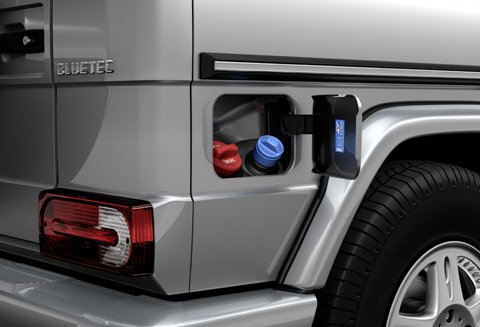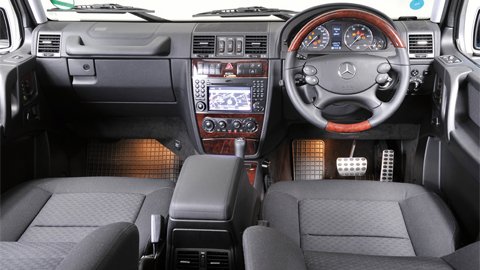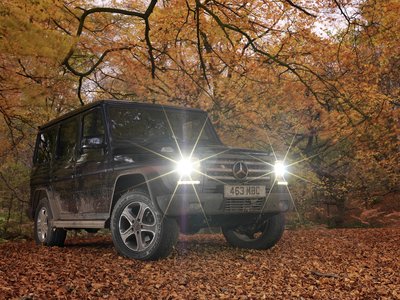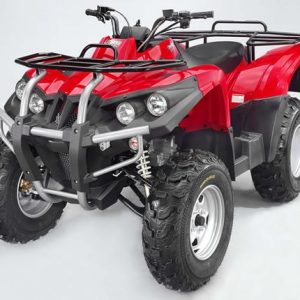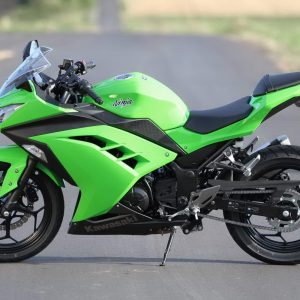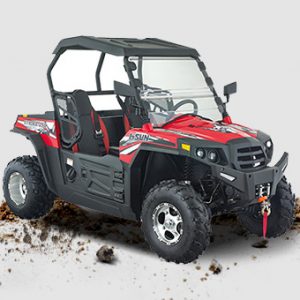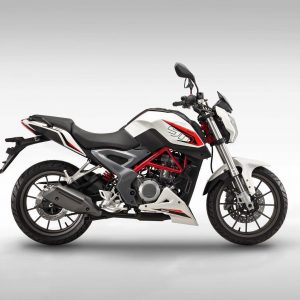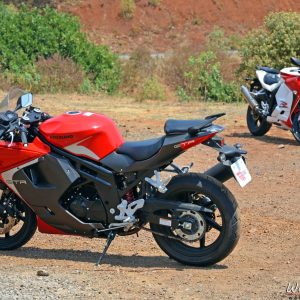Mercedes-Benz G Class G350
Features
| Engine capacity | 2,987 cc |
| Engine type | V6 |
| Compression ratio | 17.7 |
| Bore x Stroke | unknown |
| Fuel type | Diesel(Euro V) |
Mercedes-Benz G Class G350 CDI BlueTEC 211 5dr Tip Auto
Full specification:Mercedes-Benz G Class G350 CDI BlueTEC 211 5dr Tip Auto
MOST CARS THESE days are formulaic. They’re powerful, safe, capable, useable and while they all look a little different and each has its own specifications, most of them are broadly similar, like eating out at any one of a number of high-street restaurants.
The G-Class is different, and properly different as opposed to just marketing-different. If it was a restaurant it’d be an outback open air kill-you-own-food BBQ, yet with a maître d’ and silver service. Whether you love or hate the styling doesn’t matter because you absolutely won’t mistake it for anything else on the planet, so let’s get one thing out of the way, this car is unique and for many car lovers, that’s all they need to know. For the rest of you, read on…

Why it is so different is interesting. Originally designed in 1979 by Steyr-Daimler-Puch – of Haflinger and Pinzgauer fame – the G-Class is also known as the G-Wagen (G-Wagon), or Geländewagen, which literally translates to cross-country wagon. So the roots are utilitarian, and indeed the G-Wagen has sold well to armed forces across the world including Australia which even had a 6X6 version created especially.
Carmakers like to harp on about heritage even when the doorhandles are carried over to a new model, but the G-Wagen doesn’t need to make a song and dance about its history – its obvious.
The version you can buy and the one on test is the G350 Bluetec and… well, while I was going to say not utilitarian but that’d be wrong. It is very much a practical vehicle, but it’s also oddly luxurious. The seats are leather, heated and can be adjusted eight ways plus there’s a position memory. There are cornering lamps, reversing camera, Bluetooth, a good sound system, 4Gb media centre, a sunroof and cruise control. I could list more, but what makes luxury most of the time isn’t actually the gear, but the fit and finish and that’s where the G-Wagen has a sort of understated quality. Nothing about it feels cheap, which is true of many cars, but with the G comes a robust, cross-the-desert air of solidity and that is becoming increasingly rare in new cars.

Also rare is the rather confused controls – I couldn’t get Bluetooth to work without referring to the manual, the switchgear is tiny and fiddly, the interior doorhandles are cumbersome and in general the car takes some getting used to. The pedals are offset too – you need to lift your foot a long way backwards to reach the brake pedal, but you get used to that. But for some people all this is part of the charm.
On the road the G-Wagen is, again, different. You’re not short of power as the 2500kg vehicle is powered by a diesel offering 155kW and 550Nm through a fairly intelligent seven-speed automatic. Brakes are excellent, but the car does feel its weight unlike sportier 4WDs. I couldn’t initially decide whether the steering was heavy, slow, or if the car just understeered.
Eventually I settled on the tiller simply being heavier than is the norm for modern vehicles. There’s also a noticeable chirp from the tyres if you accelerate hard out of a corner, which delighted me because it meant the e-nanny wasn’t working overtime, but worried me because it also indicates the car wasn’t able to get power down to the ground as it should. It can however maintain a reasonably quick pace if you’re careful with the weight transfer and steering input, which for some people is all part of the challenge and thus enjoyment. Yet back off a little and the car is easy, docile and relaxing to drive.
We decided to go for a bit of a Saturday night jaunt to the top of a mountain to see some snow, which we kicked around in for 10 minutes and then drove back home. The route took eight hours and included motorways, very tight, wet, remote bitumen and a lot of rough dirt roads with some low-range work at the end, all at night and mostly raining then snowing. And the G-Wagen was confidence-inspiring for every inch of the way, just needing that care and thinking ahead as the engine can otherwise make promises the chassis can’t quite deliver.
Mercedes has done a great job of making a live-axle car handle more like independent suspension, but as a driver’s car the G does not approach the agility or dynamics of say a Touraeg, Range Rover Sport or a BMW. And to be fair, all of those are great cars but anodyne identikits compared to the G.

But high-speed work is not the G-Wagen’s forte. It’s meant to be a rough, tough off-roader so into low range we go. And immediately there’s disappointment. Turns out that the G has an open centre diff, which is not great these days as you’d expect at least a Torsen centre or something which intelligently splits torque/front rear.
And that would be why the front wheels are prone to chirping when you power out of corners – an inability to distribute torque properly which is subtly apparent on the road and painfully obvious off it. The G has cross-axle traction control, but as Land Rover found with the first Discovery IIs and other manufacturers have since proven, traction control alone cannot compensate for an open differential in the centre, you end up with one miserable wheel spinning and three on the ground doing nothing.
So why not just lock the centre diff? Well, you can do that, which fixes the front/rear torque split problem but that also disables electronic traction control. This is wrong, very wrong and the G is the only car I’ve seen so designed. So you’re then left with a choice between traction control and a centre diff lock (CDL), and that’s not good when you should have the simultaneous benefit of both.

But the G-Wagen has another trick and that is front and rear cross-axle locking differentials, and that’s fantastic. Lockers are absolutely wonderful in the right conditions, which is terrain that flexes the suspension yet is relatively high traction, most notably rocks. Lockers are of much less use in mud and sand, which is where traction control works extremely well, but would be even better with that locked centre diff!

Moving on from the transmission, the G-Wagen’s ground clearance is 205mm, which is not great considering its off-road purpose, but approach, ramp and departure are good at 37, 23 and 27 degrees, respectively and it’s heavy for its class too. But what the specs don’t show, and what limits the vehicle is its suspension. Tuned for high speeds, for low-range work it’s just too stiff and inflexible, which means the vehicle doesn’t flow over the ground with all four wheels nicely weighted, and in particular the front axle simply doesn’t articulate as it should. You ever see a classic Range Rover ooze over big ruts? Well, it’s nothing like that.
On the positive side visibility is the best I’ve ever seen, better even than said classic Rangies, and you’re never short of torque. The automatic is max-select, which means that when say 4th is selected the ‘box will use gears 1-4 inclusive rather than being locked in 4th, but it also seems that selecting 2nd will give you a second-gear start. Again, odd but kinda cool.

In level muddy conditions the open diff and traction control works tolerably well, pulling the car through although there’s more bouncing from the suspension than is ideal. The weekend after the G-Wagen test I instructed in a Patrol on the same tracks and was impressed at how well the big Nissan’s suspension soaked up the bumps and allowed the car to put its power down, in contrast to the Mercedes.
Yet in rocky terrain the G’s twin lockers and superb engine come into their own, and the G-Wgane can inch from rock to rock, with the driver safe in the knowledge nothing will be damaged from a touch. The stiff suspension is here an advantage at times, keeping the chassis high, but mostly lacks pliability. In hilly terrain you must engage the CDL for safety, and then you really miss traction control with that stiff suspension. If a single wheel has traction the lockers work, but if not, then leave the lockers out as they’re often counter-productive in slippery conditions and it’s just momentum. At least the G has the power and robustness to manage a bit of an uphill rush.
There was no sand available on this test, but I’d expect the Merc to do very well given its CDL, ample power and decent handling, with only the weight counting against it and while traction control is useful in sand it is not essential.
So what we have here is a competent and tough offroader, but it’s certainly not up there with the best on the market. The Defender handily beats on any terrain you care to mention thanks to ground clearance, angles and suspension pliability, plus has the marked advantage of traction control with a CDL. The Jeep Wrangler Rubicon gives away only ramp angle but in every other respect is ahead of the Merc, and having driven both these much lighter cars I can confidently say both have, overall, greater offroad capability than the G-Wagen.
But to discover the difference you’d need to be pushing hard into very difficult offroad situations, and that’s not the whole story. The Merc is light-years ahead of both competitors for onroad handling and overall refinement, and matches the Defender’s 3500kg tow rating (with a 140kg TBM mind you, but the Jeep is a miserable 2300kg) so if it becomes a question of overall capability then the G is a clear winner, and indeed I think of it as more like that benchmark of all-round prowess, the Discovery 4.
The G350 doesn’t match the Disco on-road or even for refinement, and it’s not as good off-road, but the major difference for me is the sheer rugged bushability of the G – in extreme situations you’re less likely to damage a G than a Disco, so if I had to go into some stormy forest at night to do a car extraction I’d take the Merc. It wouldn’t take much to improve it still further – enable traction control with the centre diff locked, a slight suspension lift, taller tyres and disconnecting swaybars would do wonders.


From a practical, overlanding point of view the G-Wagen has several good points and a few poor ones. Cargo room behind the second row is not bad, offering 960mm from the base of the seats to the rear door – Defender offers 1200mm, but that’s exceptional.
The Merc’s boxy shape means you’ll be able to fit lots in, especially as the wheelarches don’t much intrude on the loadspace. The rear door opens the wrong way for right-hand-drive markets, and the second row is a 40/60 split with tumble-forward, nothing special. Under the bonnet there’s very little room for accessories, and the problem is worsened by the front panels which, ah-la Defender, cover part of the engine bay.
The battery is, bizarrely, accessed via a panel in the second row footwell, with no space for a second unit and it’d be a pain to get to, plus it’s a long way to run high-amp winch cables to the front. The glovebox and centre console are small, there’s just one drinks holder and the dash is somewhat fiddly. You could add accessories such as extra 12V sockets, but there’s too much going on with the dash as it is. I’d want to lose some of the luxo-kit in exchange for simplicity and weight, and indeed such a version of the G exists, the G-Professional, sadly not available in Australia.

Ultimately, the G-Class is a car like no other. It is quick enough on-road, rewarding effort and precision but without any of that boring ease-of-use you find in modern cars. Offroad it is among if not quite with the best, yet its betters cannot match its high-speed dynamics, far less its (relative) refinement. It has presence, heritage, practicality, rarity, reliability and is far from being just a toy or trophy car but is a versatile vehicle you can use on a daily basis. And for me, it also offers something you don’t get from identikit, me-too vehicles – the increasingly rare experience that is sheer pleasure of ownership. I’d love to own one, maybe two and I can’t recommend a car more highly than that.
Interested in a G-Wagen? Of course you are. Here’s the Australian Gelandewagen Owners Association.
MERCEDES-BENZ G-CLASS G350 GALLERY
WHY SO EXPENSIVE AND WHY CAN’T WE HAVE MORE OF THEM?
The G is around $160k by the time you get it onto the road. This is, everyone agrees, far too much. I think at $70 or $80k there would be far more demand, and so do Mercedes – but the problem is the car costs too much to build, being so old so the costs are what they are. It’s also a relatively low-volume vehicle.
Land Rover face a similar problem with Defender. At least resale for Gs would be high, as if you bought a GL class and G class today I know which will be worth more in 2045.
Think of how much a top-end camper trailer costs, more than a new ute. Yet there’s nothing like the complexity. It’s all to do with efficiency of production and amortisation of costs, neither of which work for the G because it’s so old…yet that very age is the basis of the car’s considerable attraction. There will never, ever, be new cars on the market like G-Class or Defender. Last chances, guys and girls.
G-CLASS VS…
If you want an olde-world, capable 4X4 (and why wouldn’t you) then you can buy a classic Range Rover or a new(ish) G-Class. If you buy the Rangie be aware it’s like owning a dog, a lifestyle choice not just possession of goods. Rangies are high maintenance, delivering emotional highs and lows on a daily basis that you need to work for. They’re also relatively common. The G would be safer bet. Has much of the Rangie’s charm, is rarer, and frankly has this concept known as “reliability” so would be a much more sensible choice. I realise now all the Ranige owners will be coming around my house to throw broken CVs through the window, but I’m not too bothered as they need to get their cars going first so I’ve got a while.
Defender. You can think of a G as a Defender with a luxury interior (which ensures I’ve now also upset Defender owners and G owners). But it’s true. The basic design of strong chassis, twin live axles, even the body is more or less the same, but the G is more liveable, more modern and in the case of the G350, much more luxurious. If you want a Defender for the sake of a Defender, consider a G instead – unless you want to do actual work.
Utiliatrian though the G may be, the Defender has it beat when a job needs to be done. The Land Rover is better offroad – clearance, flex, angles, traction control (in TD5 and later). Both can tow 3500kg, but the G has a mere 140kg TBM. There’s more room in the back of the Defender, and it has a much greater payload (around 1000kg in the 110 wagon) and there’s far more aftermarket accessories. As a tool in the rough, good though the G is, the Defender is better.
But then there’s this:
THE ADF’S G-WAGENS
I’ve had a drive of them and here’s one. An amazing vehicle!
TOO SLOW? TRY THIS, THE AMG G 63
The AMG version. O-100 in 5.4 seconds, V8. A crazy 400kW and 760Nm for a chassis designed to lug a load…this is perhaps the one car I’d choose over a Range Rover Sport if I had just the one vehicle for the rest of my life.




